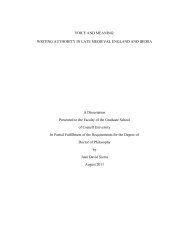Briana Anderson - Cornell University
Briana Anderson - Cornell University
Briana Anderson - Cornell University
You also want an ePaper? Increase the reach of your titles
YUMPU automatically turns print PDFs into web optimized ePapers that Google loves.
Explaining the Attractiveness-Credibility Link: Attribution Theory – Social<br />
Psychology<br />
9<br />
The majority of advertising studies related to the role of attractiveness in<br />
source credibility judgments offers evidence that people often make more positive<br />
judgments regarding a communicator’s credibility based primarily on a physical<br />
attractiveness cue. Many of these studies are rooted in the substantive domain<br />
(Brinberg & McGrath, 1982), meaning that they begin with a practical problem, i.e.<br />
how to gain credibility for a certain product in a certain context, and develop a<br />
methodology to test that particular study. These studies often draw from differing<br />
theories to explain why this phenomenon occurs. Attribution theory offers a<br />
theoretical framework through which these studies can be interpreted.<br />
Attribution theory has its origins in Fritz Heider’s (1958) The Psychology of<br />
Interpersonal Relations, which offers a theoretical base for how individuals make<br />
causal inferences about everyday occurrences, that is, at a fundamental level people<br />
try to make sense of every phenomenon they encounter. An important concept in<br />
attribution theory is that of inferential processes – people arrive at judgments of causes<br />
based on an analytical process. Basically, people tend to overestimate the impact of<br />
features that are salient in the perceiver’s environment. The first step in forming an<br />
impression of a person is to observe their behavior. Those elements that are most<br />
salient, i.e. most prominent from the perspective of the perceiver will be the most<br />
important when a person makes a judgment.<br />
From this theoretical base, research has shown that on contact with the<br />
appearance or behavior of another, a person will make inferences about the person or<br />
organization that correspond with the observation. This is known as the ‘fundamental<br />
attribution error’ (Ross, 1977; Jones & Nisbett, 1972) because people attribute<br />
qualities to people based on this initial impression that actually may be caused by

















